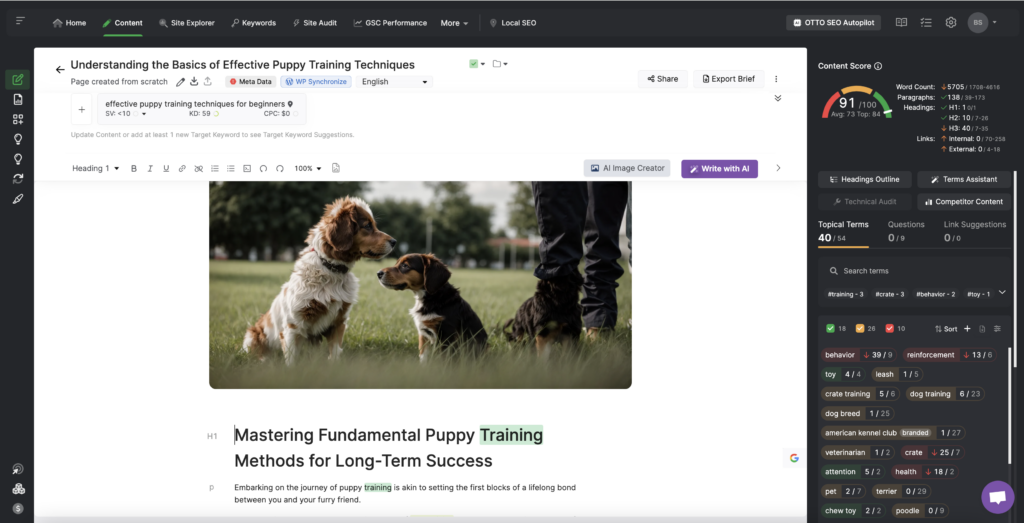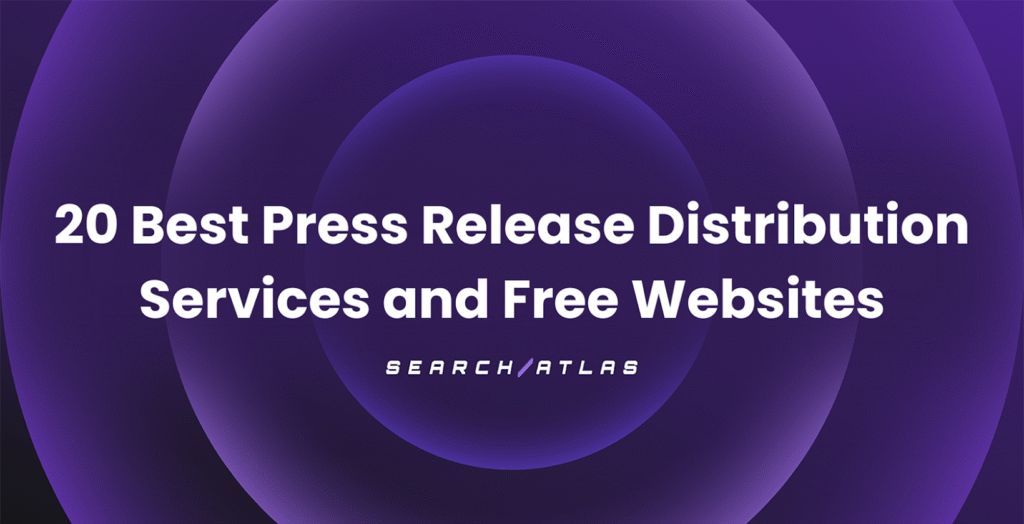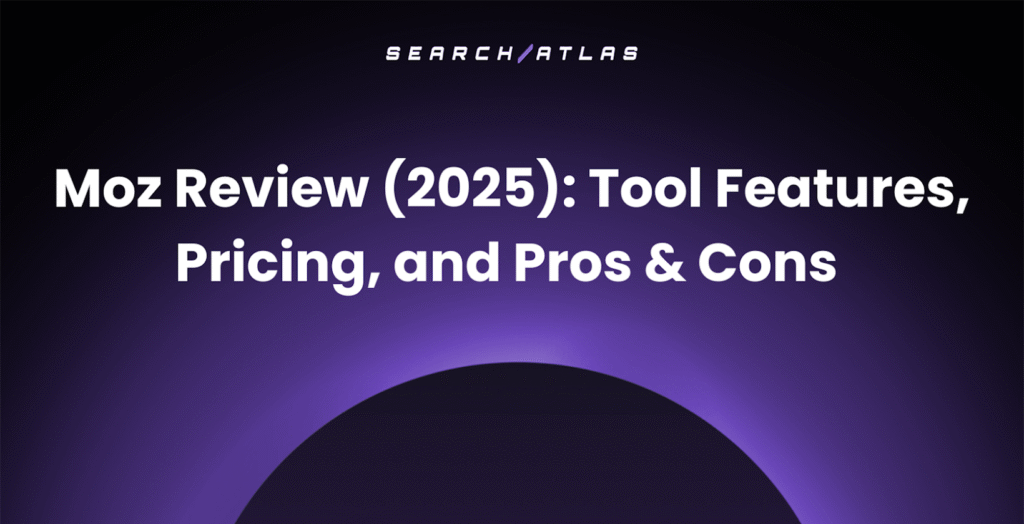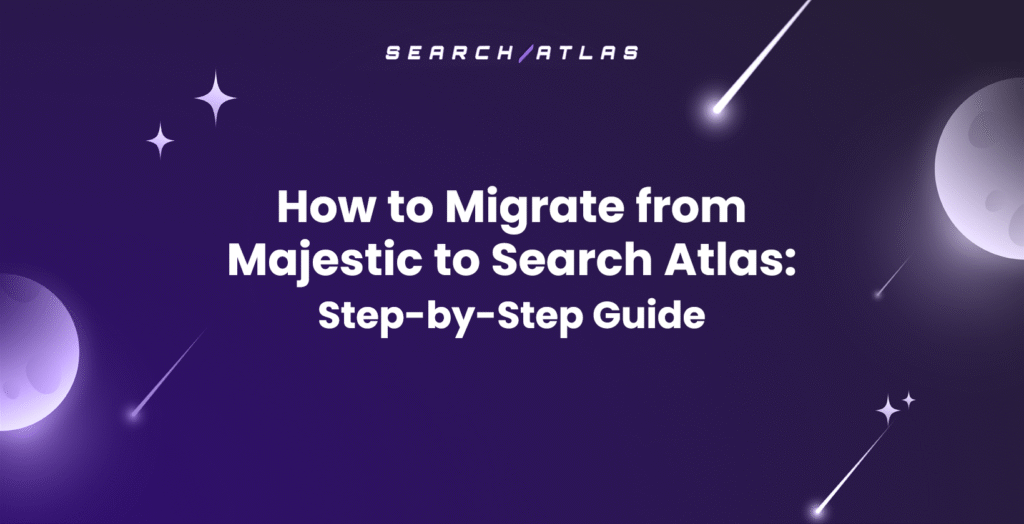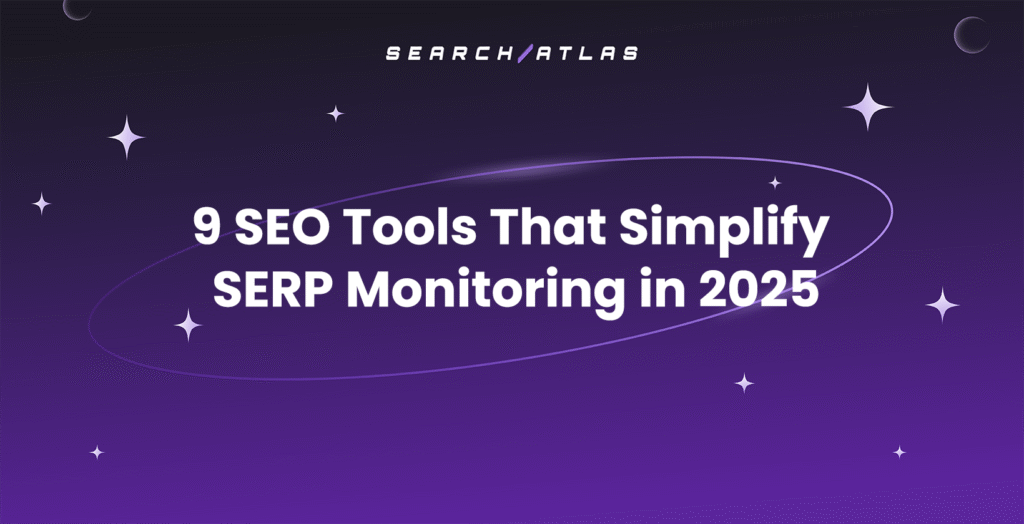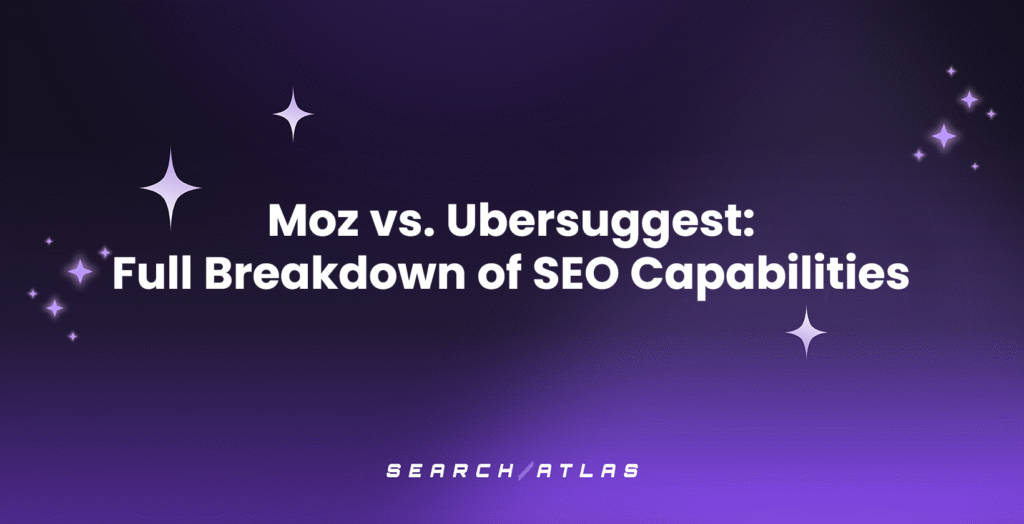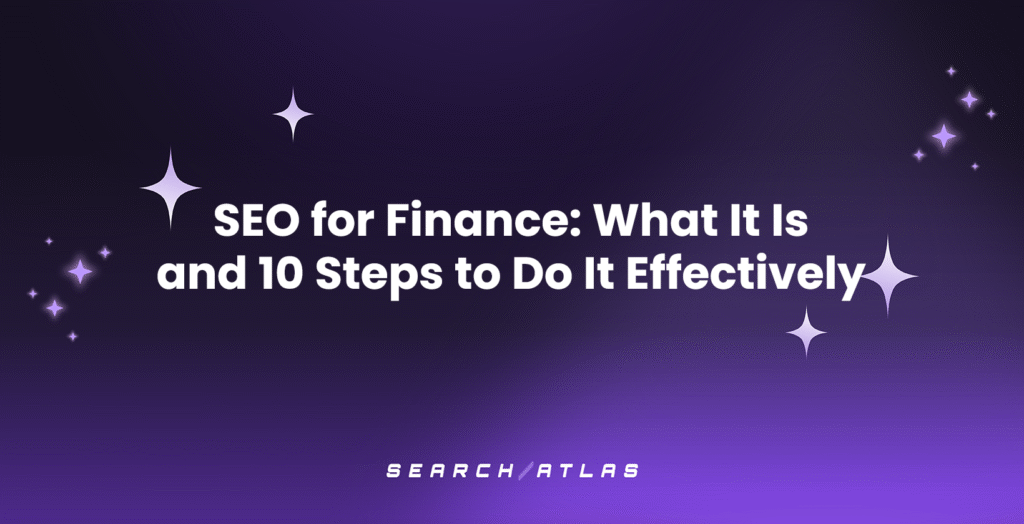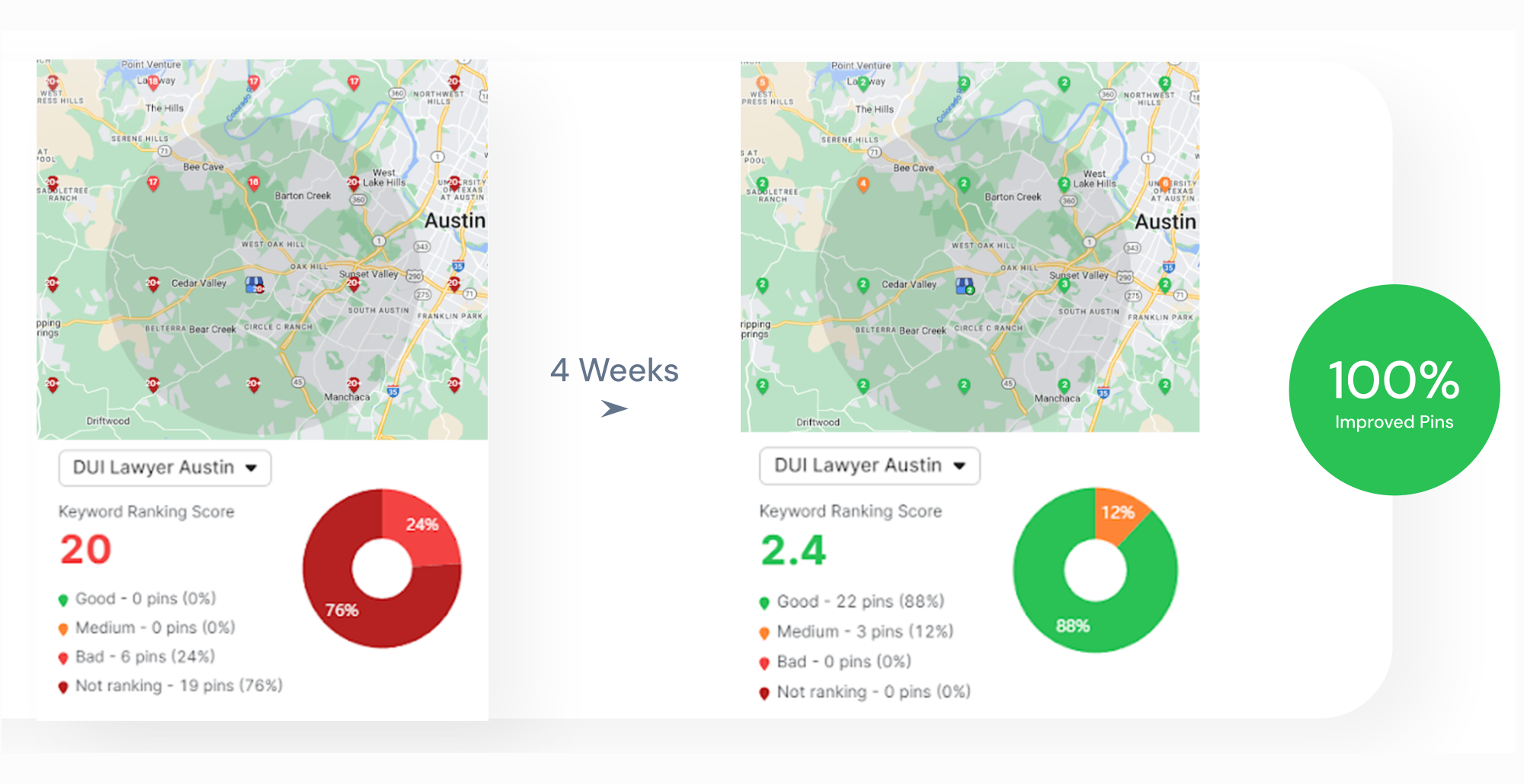SEO (Search Engine Optimization) content refers to any type of digital material optimized to rank higher on search engines and attract organic traffic. Unlike traditional content, SEO content follows structured optimization strategies, including keyword research, search intent alignment, and technical SEO best practices to improve visibility. SEO content is of immense significance in online marketing, as it helps businesses reach their target audience, build authority, and drive conversions.
The effectiveness of SEO content depends on the key factors of content quality, freshness, depth, and relevance. Creating SEO-optimized content involves conducting keyword research, structuring content with clear headings, optimizing metadata, and integrating internal and external links. A well-executed SEO content guide enhances SEO content marketing, ensuring long-term search visibility and audience growth.
What Is SEO Content?
SEO content is any piece of content specifically designed and structured to rank in search engines and drive organic traffic. SEO content includes blog posts, landing pages, product descriptions, and multimedia assets like infographics and videos that align with search intent, relevance, and user engagement. Unlike general web content, SEO-optimized content is strategically crafted using data-driven techniques such as keyword placement and structured formatting to maximize reach and engagement.
Common SEO content mistakes include keyword stuffing, thin content, and poor readability. Overloading content with keywords can trigger search engine penalties, while shallow or poorly structured content struggles to rank. Beyond correct keyword usage, SEO content benefits from on-page optimizations such as meta tags, structured data, internal linking, and user-friendly formatting to enhance visibility and engagement.
As SEO evolves, AI-generated content, conversational search, and video SEO are shaping the future of content creation. AI tools assist in content generation, but search engines continue to favor human-edited, authoritative content that meets E-E-A-T (Experience, Expertise, Authoritativeness, Trustworthiness) standards.
What Is Content Optimization in Overall SEO Strategy?
Content optimization is the process of improving content to enhance its visibility, relevance, and performance in search engines. Content optimization ensures that content is structured, formatted, and enriched with SEO elements that align with user intent, keyword targeting, and search engine guidelines. Unlike content creation, which focuses on producing new material, content optimization fine-tunes existing content to maximize engagement, organic traffic, and rankings in search engines.
A content SEO strategy is most effective when treated as an ongoing process rather than a one-time effort. It integrates continuous optimization, ensuring content remains relevant, aligned with search intent, and technically sound. Regular updates, historical refinements, and performance analysis help sustain rankings and adapt to evolving search algorithms, making SEO a long-term, strategic investment.
What Is the Importance of SEO Content?
SEO content is the foundation of a website’s visibility, authority, and long-term organic growth. SEO content serves as the primary means for search engines to assess a site’s relevance and expertise, directly influencing its rankings. Without well-optimized content, even a technically sound website would struggle to gain traction in search results.
Beyond rankings, SEO content establishes topical authority by demonstrating subject-matter expertise. Search engines prioritize websites that consistently publish in-depth, relevant, and well-structured content, allowing them to rank for a broader range of industry-specific queries. This alignment with search intent ensures that content meets user needs at different stages of their journey, increasing the likelihood of engagement and conversions.
A well-developed content strategy improves critical engagement signals, such as bounce rate, dwell time, and click-through rate, all of which contribute to search performance. Structurally optimized content, with clear formatting and logical progression, enhances readability and accessibility. Search engines favor content that is easy to navigate, informative, and well-integrated into a site’s overall structure through internal linking and metadata optimization.
SEO content plays a central role in off-page strategies by attracting natural backlinks from authoritative sources.
What Are the Most Important Content SEO Ranking Factors?
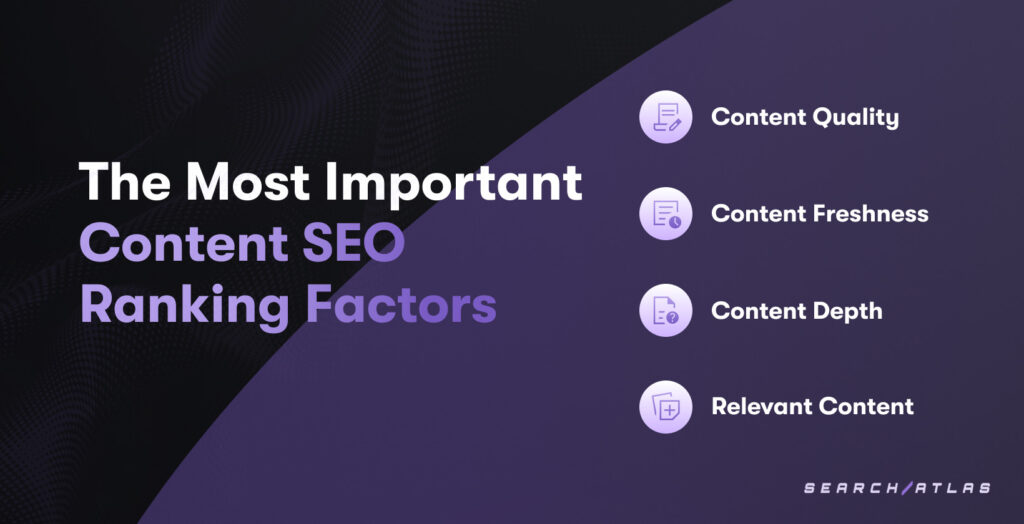
Content SEO ranking factors determine how well a piece of content performs in search engine results. Content SEO ranking factors align with Google’s search quality evaluation signals, such as E-E-A-T, and user experience metrics like engagement, dwell time, and retention. Optimizing content based on these ranking factors enhances search visibility and improves organic traffic performance.
The most important content SEO ranking factors are content quality, content freshness, content depth, and relevant content.
- Content Quality. Ensuring informative, well-researched, and engaging content answers user queries comprehensively. Search engines prioritize content that offers original insights, expert-backed information, and high readability.
- Content Freshness. Updating content regularly to maintain ongoing relevance to search engines. Google’s Query Deserves Freshness (QDF) algorithm favors up-to-date information, especially for time-sensitive topics.
- Content Depth. Covering topics in detail and addressing related queries, subtopics, and latent semantic indexing (LSI) terms to improve topical authority. Google rewards content that provides comprehensive entity relationships and contextual coverage over superficial keyword inclusion.
- Relevant Content. Matching search intent to provide users with exactly what they need. Search engines analyze semantic relevance, click-through rates (CTR), dwell time, and pogo-sticking behavior to assess whether content satisfies user intent.
In addition to content-related SEO ranking factors, other SEO ranking factors impact search visibility. These include page speed, mobile-friendliness, HTTPS security, crawlability, and backlink authority. A well-rounded SEO strategy requires balancing both on-page, off-page, and technical optimizations to achieve sustainable ranking success.
How to Create SEO Content That Ranks?
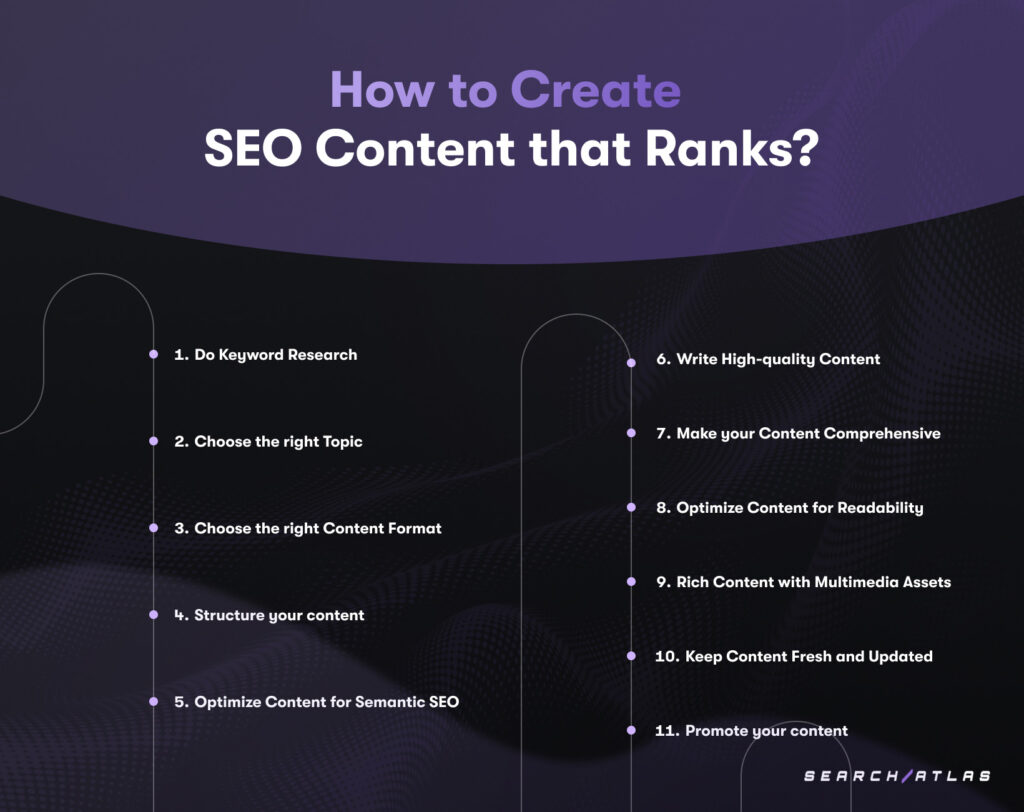
Creating SEO content that ranks requires a strategy that aligns with search engine algorithms, user intent, and best optimization practices. Following structured SEO content writing best practices ensures businesses improve content visibility, engagement, and ranking potential.
A step-by-step process to create SEO content that ranks is listed below.
1. Do Keyword Research and Understand Search Intent
Keyword research is the foundation of SEO content creation, ensuring that your content aligns with user queries, industry trends, and search engine algorithms. Without targeted keywords, even well-written content may struggle to gain visibility. The key to effective keyword research is understanding search intent (informational, navigational, transactional, or commercial), which is the reason behind a user’s query.
The Search Atlas Keyword Magic Tool simplifies keyword research by providing key metrics such as search intent, SV (Search Volume), keyword difficulty, competitor pressure, CPC (Cost-Per-Click), and PPCD (Pay-Per-Click Difficulty). Search Atlas Keyword Magic Tool helps content creators identify high-impact keywords that align with user needs while avoiding overly competitive terms.

To use Search Atlas for keyword research, first enter a broad topic or seed keyword into the Search Atlas Keyword Magic Tool.
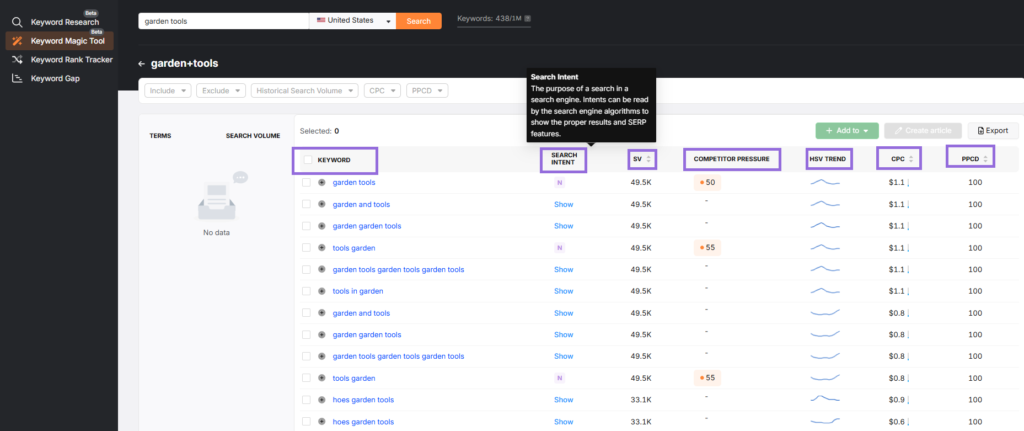
Analyze keyword variations, including long-tail keywords that capture more specific user queries.
Identify search intent classifications to ensure the content aligns with user expectations.
Evaluate search volume, competition, and CPC to prioritize the most effective keywords.

Finally, export selected keywords or add them to your SEO strategy for content planning.
In addition to traditional keyword research, the Search Atlas Keyword Gap Analysis Tool helps identify keywords that competitors rank for but your site does not. The Search Atlas Keyword Gap Tool allows you to do the steps listed below.
- Compare up to six domains to find gaps in keyword strategy.
- Analyze missing, shared, and untapped keywords to prioritize new content opportunities.
- Refine your content plan by targeting high-value, low-competition keywords.
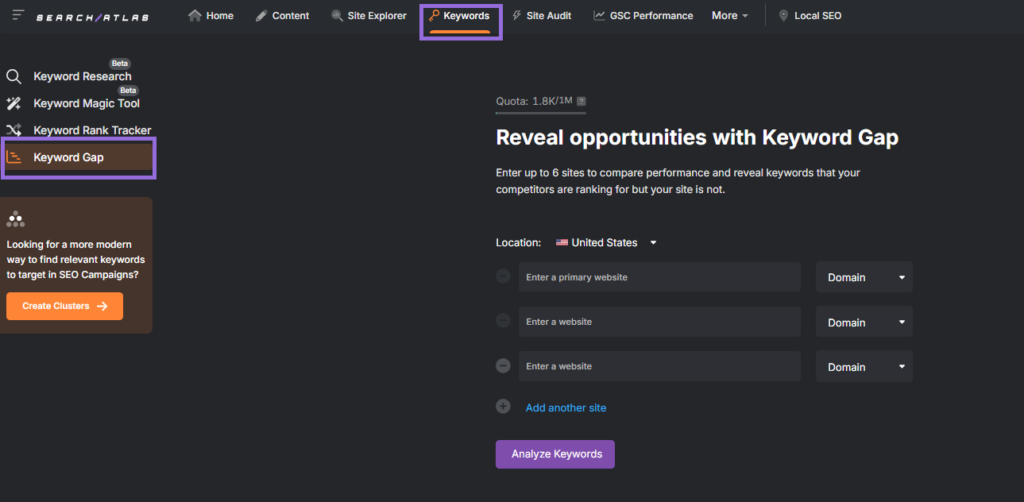
2. Choose the Right Topic Based on Targeted Keywords
Choosing the right topic based on targeted keywords is crucial for SEO success, as it determines content relevance, search visibility, and long-term traffic potential. A well-chosen topic should align with your audience’s needs, business goals, and keyword opportunities while supporting internal linking and website structure.
To maximize SEO impact, prioritize long-tail keywords, topical clusters, and evergreen content.
- Long-tail keywords that capture specific user queries and conversational search patterns.
- Topical clusters that connect related articles, strengthening overall website authority.
- Evergreen content that remains relevant over time, reducing the need for frequent updates.
The Topical Map Tool in Search Atlas simplifies topic selection by automatically generating detailed visual representations of related topics. The Search Atlas Topical Maps Tool allows users to define a pillar page URL and choose a language for topic mapping. Users can specify the number of clusters (categories), long tails (long-tail keywords), and titles (article ideas) per cluster.

Define niche, search intent, audience, and business purpose to generate a relevant content structure.
The Search Atlas Topical Maps Tool provides organized categories with suggested article titles and keywords, ensuring a well-structured SEO content strategy.
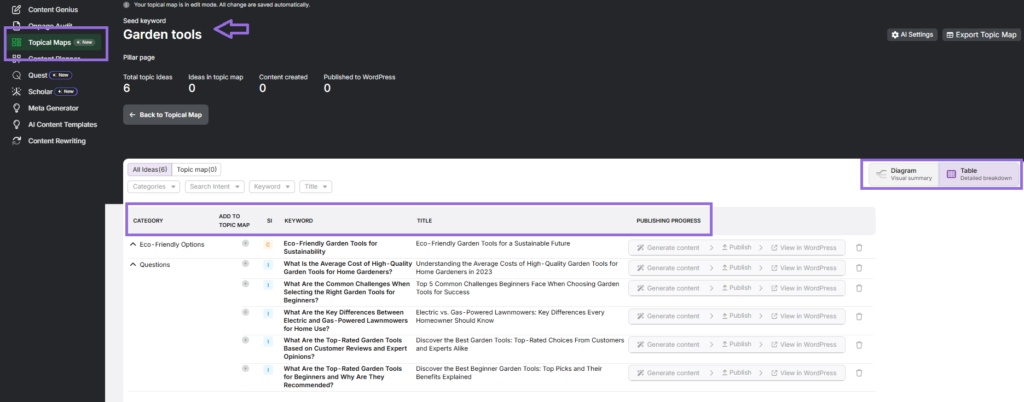
Users can generate content, publish it in WordPress, or export the topical map for content planning.
Search Atlas Keyword Magic Tool uncovers high-impact keywords, while the Search Atlas Keyword Gap Analysis Tool helps identify topic opportunities that competitors are leveraging. Combining topical maps with these Search Atlas tools for keyword research creates a fully optimized content ecosystem, strengthening your SEO authority and internal linking strategy.
3. Choose the Right Content Format Based on Search Intent
Choosing the right content format is necessary for matching user expectations, improving engagement, and increasing rankings.
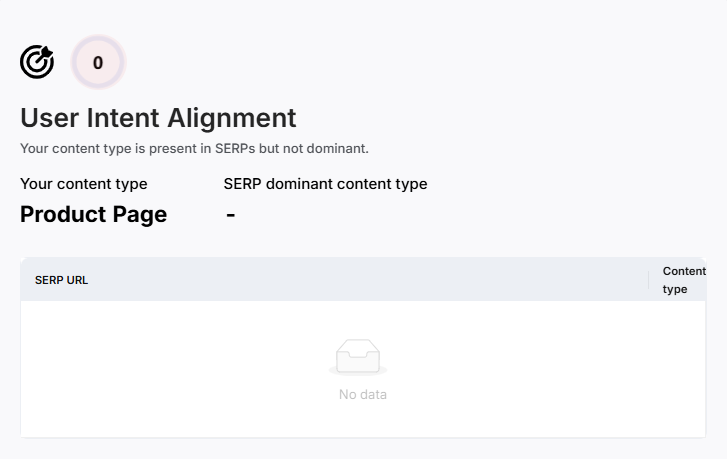
Primary search intent categories and the appropriate content formats are listed below.
- Informational Intent. Users seek knowledge or answers. Best formats include blog posts and guides, listicles, FAQs, and infographics.
- Blog posts & guides (“How to Create SEO Content”).
- Listicles (“Top 10 SEO Strategies”).
- FAQs (“What Is Search Intent in SEO?”).
- Infographics & visual content.
- Navigational Intent. Users look for a specific website or brand. Best formats include brand pages/about pages, comparison pages, and tutorials.
- Brand pages or About pages.
- Comparison pages (“Google Search Console vs. Search Atlas”).
- Tutorials explaining brand-related topics.
- Transactional Intent. Users are ready to take action. Best formats include product and category pages, landing pages, trial pages, case studies, and testimonials.
- Product pages & category pages.
- Landing pages with CTAs.
- Free trial/demo pages,
- Case studies & testimonials.
- Commercial Investigation. Users are comparing options before purchasing. Best formats include product comparisons, reviews, guides, and pricing pages.
- Product comparisons (“Best SEO Tools for Agencies”).
- Reviews & buyer’s guides.
- Pricing pages.
The sure way to determine the ideal format is by analyzing Google’s SERP results. Specifically, the top-ranking pages and featured snippets.
If Google highlights a paragraph, list, table, or video in the featured snippet, structure your content similarly. If Google shows an H2 with a numbered list for “how to optimize content for SEO,” follow a similar framework in your post.
By reverse-engineering Google’s top results, you ensure your content format matches user expectations, improves readability, and increases ranking potential.
4. Structure Your Content with Contextual Headings
Structuring your content with contextual headings is essential for SEO, readability, and user experience. Properly formatted heading structure (H1-H3) helps search engines understand content hierarchy, making it easier to rank for primary and related queries.
Tips for structuring your content with contextual headings are listed below.
- The H1 should be unique, keyword-optimized, and directly reflect the page’s main subject.
- Each H2 should represent a major subtopic that supports the main idea. Include related keywords and entities where relevant to strengthen topical authority.
- H3s should add depth to H2s, presenting lists, FAQs, or supporting information.
Search engines prioritize content that answers user queries directly, so headings should match common search patterns (e.g., “How to…,” “What is…,” “Best ways to…”). Enter your primary query into Google and analyze how the top results frame their headings and subheadings.
Formatting some H2/H3s as questions or step-by-step lists increases the chances of ranking for Google’s featured snippets and voice search results.
The sequence of headings should guide readers smoothly through the content, avoiding abrupt topic shifts or disconnected sections.
To ensure headings are well-structured and contribute to contextual clarity, you can use the Search Atlas Content Scholar Tool to analyze and refine your content.
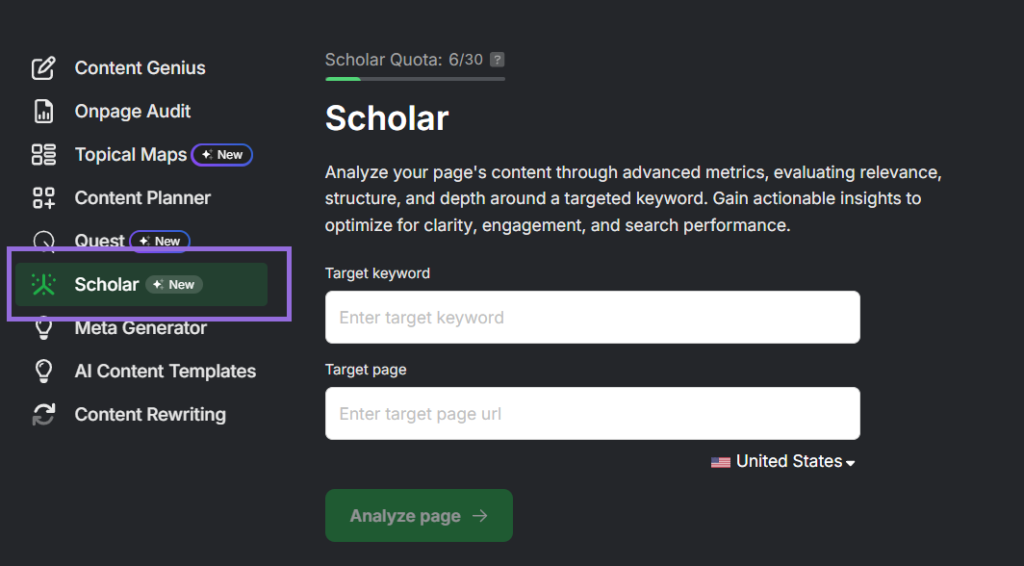
The Search Atlas Scholar Tool evaluates how well headings transition between sections, whether they align with search intent, and if they effectively structure the content for readability and ranking, among other functions.
The Contextual Flow feature in the Search Atlas Scholar Tool provides insights into heading relationships, ensuring each section logically connects to the next.

Integrating the Search Atlas Scholar Tool’s AI-driven analysis can help you fine-tune your headings, improve content clarity, and enhance topical authority.
5. Optimize Your Content for Semantic SEO
Optimizing your content for semantic SEO improves search engine understanding of content context by incorporating related entities, keyword relationships, and structured data rather than relying solely on exact-match keywords. The semantic SEO approach enhances topical authority, improves rankings for long-tail queries, and aligns with modern search algorithms.
Optimizing content for microsemantics and related entities ensures stronger rankings, higher engagement, and long-term search relevance.
6. Write High-quality Content
Writing high-quality content is the foundation of effective SEO and digital engagement. Search engines prioritize unique content (information gain), while audiences seek content that is valuable, engaging, and easy to consume. Writing for SEO requires balancing search engine algorithms with human readability, ensuring that content meets both ranking criteria and user expectations.
The core attributes of high-quality SEO content include depth, accuracy, readability, and originality. Articles that thoroughly address topics, provide actionable insights and cite credible sources perform better in search rankings.
Additionally, structuring content with logical headings (H1-H3), bullet points, and multimedia elements (images, videos, infographics) improves user experience and search visibility.
Use the Search Atlas Content Genius Tool to save time by automating keyword research, content structuring, and AI-assisted production. Whether you are writing manually or using AI, the Search Atlas Content Genius Tool ensures that content aligns with search intent and SEO best practices.
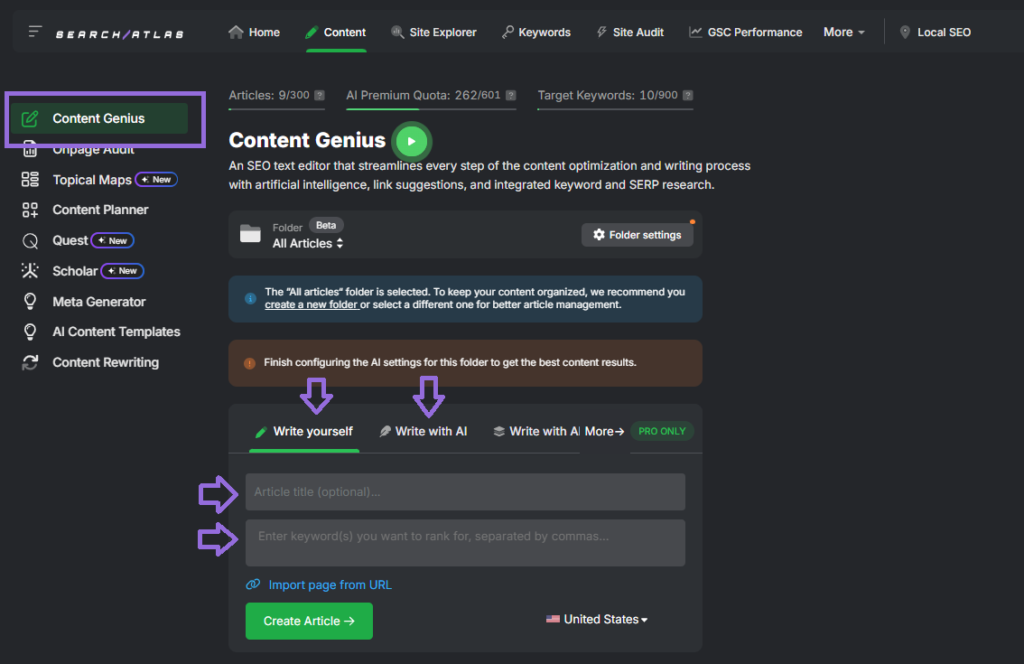
Search Atlas Content Genius offers three content creation workflows. These are listed below.
- Write Yourself. Manually draft content while using AI-powered SEO suggestions for keywords, headings, and metadata.
- Write with AI. AI-generate content based on target keywords, competitor data, and search intent.
- Write with AI in Bulk. Batch-generate multiple AI articles for topical clusters or large-scale content production.
For optimal SEO results, use Write With AI mode in combination with manual editing to refine AI-generated drafts.
Search Atlas Content Genius Tool analyzes SERP data to suggest keyword placements, content length, and heading structures. The AI outlines content based on competitor analysis, ensuring it aligns with high-ranking search results.

The AI provides content optimization recommendations, including semantic keyword suggestions, NLP terms, and competitor-based insights.
Before publishing, refine SEO elements using Search Atlas Content Genius’s built-in features like the metadata generator, image generator, and internal linking recommendations. The tool integrates seamlessly with WordPress, allowing for streamlined publishing and content management.
7. Make Your Content Comprehensive and In-Depth
Comprehensive and in-depth content ranks higher in search results because it fully answers user queries. Search engines prioritize well-researched content that covers topics holistically and provides valuable insights.
The tips for making your content comprehensive and in-depth are listed below.
- Cover all relevant subtopics. Address all aspects of a subject to ensure completeness.
- Answer user questions. Use sources like Google’s “People Also Ask” (PAA) to anticipate related queries.
- Use keyword clustering. Incorporate semantically related terms to enhance relevance.
- Provide examples, case studies, and actionable steps. Ensure practical value.
- Include structured data (FAQ schema). Help search engines better understand and display content.
A well-researched, detailed article establishes authority and improves the likelihood of ranking in featured snippets and top search results. The Search Atlas Content Genius Tool assists in content depth optimization by analyzing the top 20 search results and extracting related terms, competitor headings, and semantic connections.
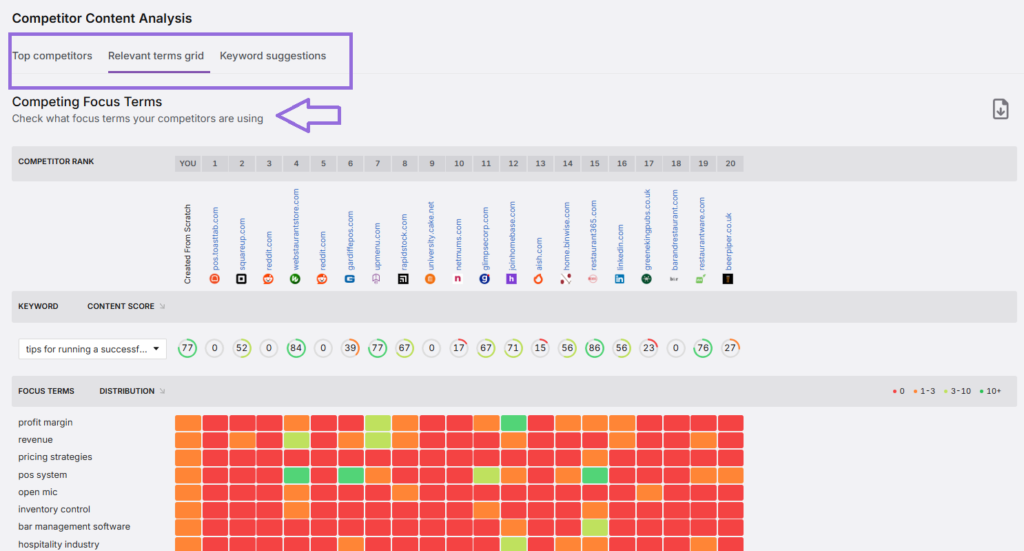
The Search Atlas Scholar Tool offers valuable information by analyzing content in terms of factuality, information gain, and query relevance.
Use the Search Atlas Scholar Tool and navigate to the Factuality section to evaluate how effectively your content integrates precise, relevant, and actionable information, aligning with semantic SEO principles.
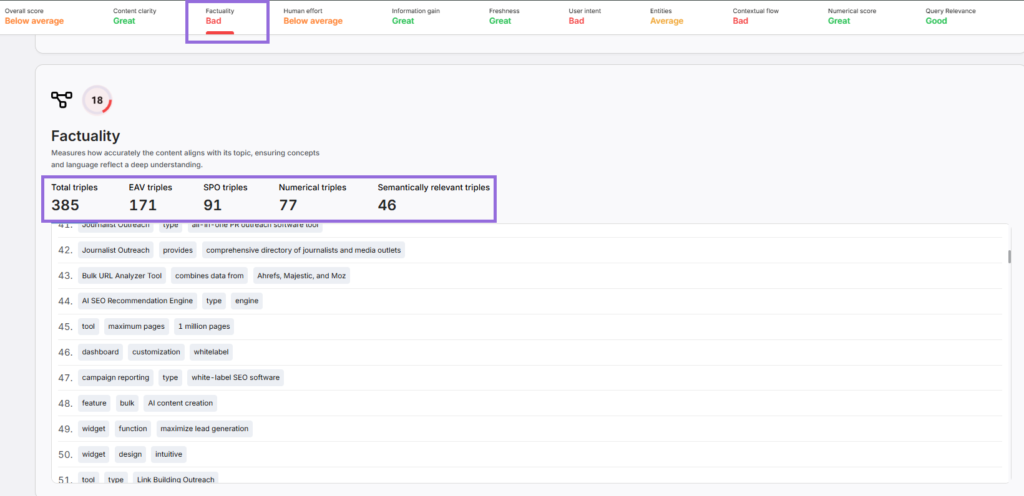
Search Atlas Scholar Tool highlights EAV triples, SPO triples, numerical triples, and semantically relevant triples. EAV triples, SPO triples, numerical triples, and semantically relevant triples are structured data models that help search engines interpret content by breaking information into subject-attribute-value relationships, enabling better contextual understanding, entity recognition, and enhanced search visibility.
The Information Gain section emphasizes the importance of original insights that set your content apart from competitors.
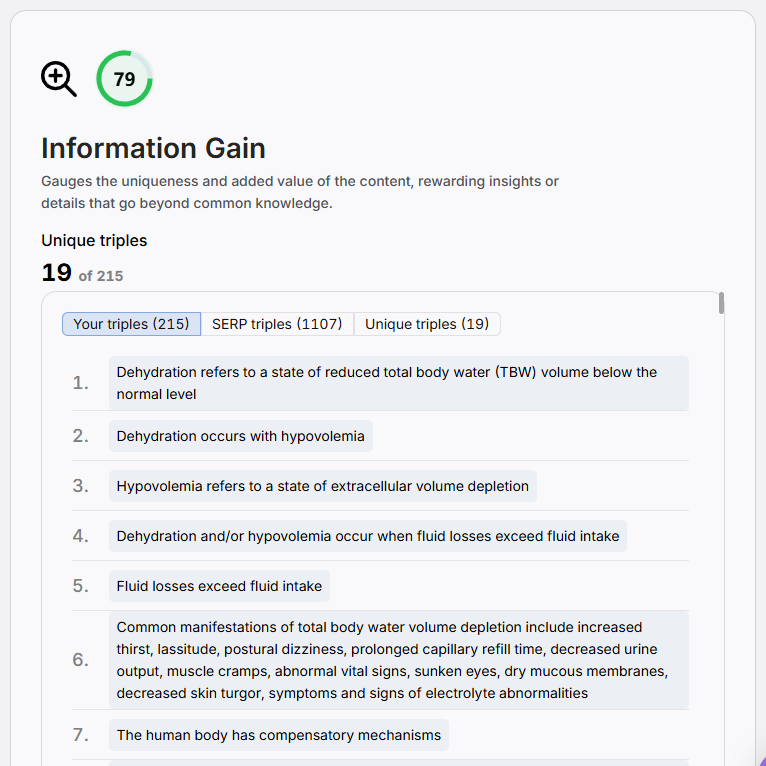
The Query Relevance section assesses how well your target keyword and page URL align with the page title and headings, ensuring they collectively address user intent and enhance search query alignment.
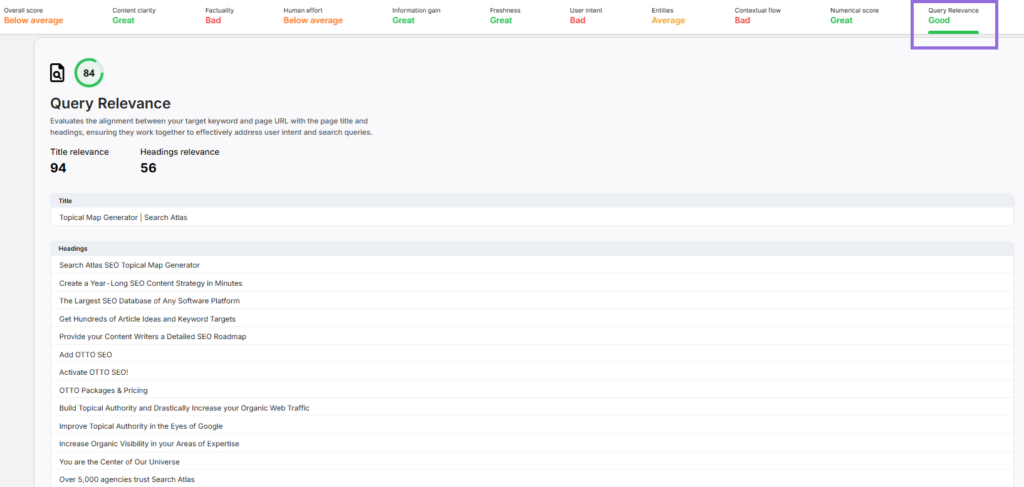
8. Optimize Your Content for Readability and Clarity
Readability is a crucial SEO factor that affects user experience and engagement. Content that is easy to read and visually structured performs better in search rankings. Readability optimization involves structuring content for clarity, conciseness, and user accessibility. Well-optimized content improves dwell time and decreases bounce rates.
Best practices for readability are listed below.
- Use headings and subheadings. Organize content with H2 and H3 tags for logical flow.
- Improve sentence flow. Use transition words to create a smooth reading experience.
- Optimize font and spacing. Ensure font size and line spacing enhance readability.
- Use readability tools. Tools like Search Atlas Scholar, Search Atlas Content Genius, and Grammarly help refine text clarity.
- Test mobile friendliness. Ensure the content is accessible and readable on all devices.
Search Atlas Scholar’s Readability section provides readability analysis and suggests improvements regarding the grade and complexity of your content.
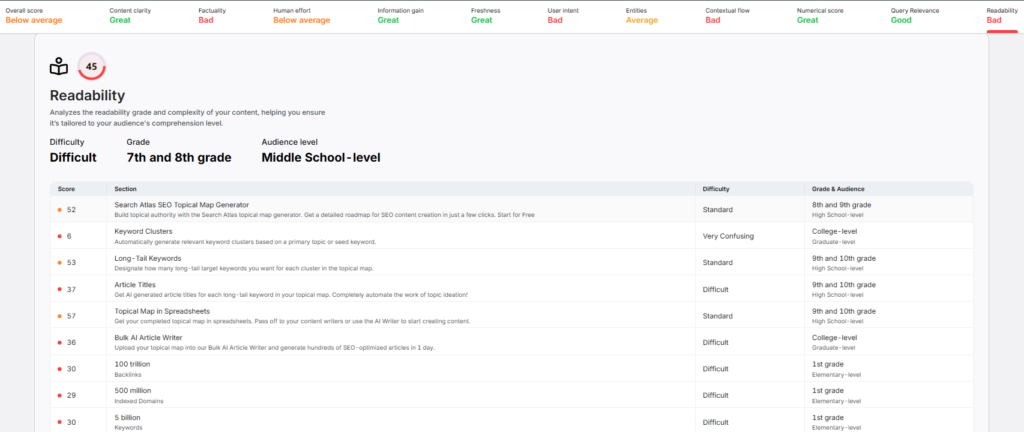
9. Enrich Your Content with Multimedia Assets
Enriching content with multimedia assets enhances engagement, improves user experience, and boosts SEO rankings. Multimedia elements such as images, videos, infographics, and interactive features help break up large text blocks, making content easier to digest while increasing dwell time. Search engines favor content with diverse media types, as it signals a richer, more informative experience for users.
High-quality visuals and videos are more likely to be shared across social media, increasing visibility and backlinks. Furthermore, properly optimized images and videos appear in Google Image and Video search results, expanding organic reach.
To optimize multimedia assets effectively, use high-quality relevant media, optimize file sizes, add descriptive alt text and titles, and implement schema markup.
- Use high-quality, relevant media. Ensure images, videos, and infographics support and add value to the content.
- Optimize file sizes. Compress images and videos without losing quality to improve page speed.
- Add descriptive alt text and titles. Help search engines understand media content and improve accessibility.
- Implement schema markup. Use structured data to enhance visibility in rich results.
10. Analyze Your Content and Update It Based on User Behavior Changes
Analyzing and updating your content is crucial because search algorithms and user behaviors constantly evolve. Content that ranks well today may lose visibility if it no longer aligns with shifting search intent, engagement trends, or changes in SERP features.
To maintain content performance, track the three key areas listed below.
- Search Performance Metrics. Use Google Search Console to monitor click-through rates (CTR), impressions, and ranking fluctuations. A drop in CTR may indicate the need to optimize title tags, meta descriptions, or content relevance.
- User Engagement Signals. Measure bounce rate, dwell time, and scroll depth to understand how users interact with your content. A high bounce rate may indicate a mismatch with search intent, while a low scroll depth suggests content structure issues.
- SERP Feature Visibility. Monitor how frequently featured snippets, People Also Ask (PAA), and knowledge panels appear for your target keywords. If competitors dominate these features, refine content formatting, structure, and schema markup to improve visibility.
Regularly updating content based on these performance insights helps maintain search relevance and improve rankings over time.
11. Promote Your Content to Increase Visibility
Promoting your content requires strategic distribution across multiple platforms to attract backlinks, engagement, and brand authority signals. Search engines reward content that demonstrates high E-E-A-T (Experience, Expertise, Authoritativeness, Trustworthiness), and off-page factors like backlinks and social signals contribute significantly to rankings.
To achieve organic discovery and social distribution, share content across LinkedIn, Twitter (X), Facebook Groups, and niche communities with customized messaging and engagement hooks.
Use Reddit, Quora, and industry forums to provide value-driven responses that naturally integrate your content. Repurpose content into Twitter threads, LinkedIn carousels, and YouTube Shorts to increase discoverability.
A well-structured press release strategy can amplify content reach, drive referral traffic, and secure high-authority backlinks. Tools like Search Atlas Press Release Distribution Tool enable businesses to publish AI-optimized press releases across social media networks, Google News, and industry-specific outlets.
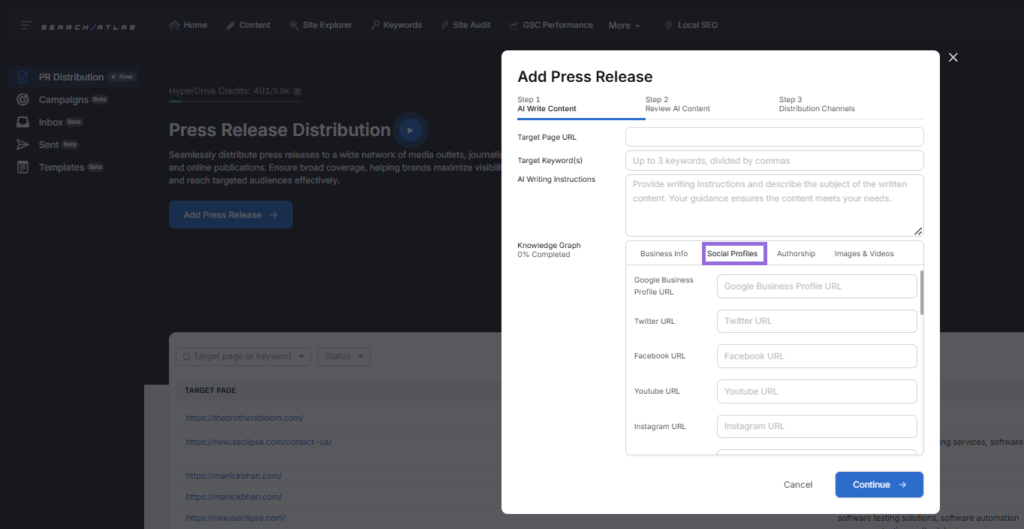
For email amplification and owned audiences, distribute content via newsletter campaigns with segmented lists, ensuring high open rates and CTRs. Use automated email sequences to nurture leads with related resources and contextual CTAs.
To accelerate link acquisition, conduct backlink gap analysis using tools like Search Atlas Backlink Research Tool and Search Atlas Site Explorer Tool. The Search Atlas Backlink Research Tool and Search Atlas Site Explorer Tool help you identify high-authority domains that have linked to similar content and reach out with personalized pitches showcasing the unique value your content offers. Guest posting and digital PR outreach can further secure high-quality backlinks.
Paid promotion can supplement organic efforts by increasing visibility in high-intent search and social spaces. Use Google Ads for keyword-targeted discovery campaigns, LinkedIn Ads for B2B thought leadership, and Facebook Ads for audience retargeting. A well-optimized paid strategy ensures your content reaches decision-makers while supporting long-term organic growth.
You create a robust amplification strategy that maximizes visibility, traffic, and search performance by diversifying content distribution across multiple channels, such as social media, PR, email, internal linking, backlink outreach, and paid promotion.
How to Automate SEO Content Creation Using Search Atlas OTTO SEO?
Search Atlas OTTO SEO enhances website optimization by automatically injecting keywords, headings, links, and structured elements directly into web pages. These elements remain hidden by default to maintain the page layout since OTTO SEO does not interpret styling. Despite being hidden, these optimizations provide immediate SEO benefits by improving content relevance and search visibility. Users can modify CSS settings to integrate these elements seamlessly into their website design.
There are six main ways Search Atlas OTTO SEO automates SEO content creation. These are listed below.
- Missing Keyword Issues. OTTO SEO identifies content gaps and integrates missing keywords naturally within the page. This improves content relevance, search intent alignment, and overall keyword coverage. By refining keyword density without over-optimization, OTTO SEO ensures compliance with search engine guidelines while boosting rankings.

- Internal Linking Opportunities. OTTO SEO detects and suggests contextually relevant internal links to enhance site structure and improve user navigation. By linking related pages with optimized anchor text, OTTO SEO distributes link equity effectively and strengthens the topical authority of interconnected content.
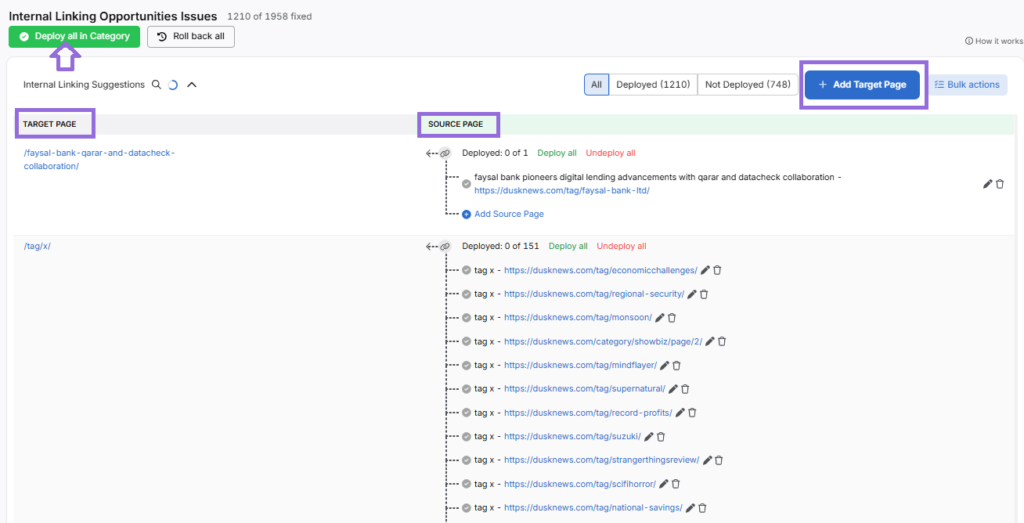
- Semantic Analysis and Knowledge Graph Optimization. OTTO SEO applies semantic analysis to enhance content comprehension for search engines. By structuring content around named entities and NLP-driven relationships, OTTO SEO improves rankings in People Also Ask and featured snippets. The integration of Google’s Knowledge Graph signals ensures content is accurately classified and contextually relevant.

- Knowledge-Based Trust and Factual Enhancement. OTTO SEO improves content trustworthiness by verifying fact-based claims and authoritative references. This process aligns content with E-E-A-T principles to strengthen credibility and increase ranking potential. Enhancing factual accuracy reduces the risk of misinformation penalties.

- Topical Maps and Supplemental Content. OTTO SEO expands website coverage by generating AI-powered topical maps that structure content into logical clusters. These recommendations help websites cover broad industry themes, ensuring relevance for primary and secondary keyword variations. Supplemental content improves long-tail keyword targeting and organic visibility.

- Custom HTML Content. OTTO SEO automates custom HTML injections directly into the web page’s Header or Body sections. These enhancements include schema markup, structured data implementation, and on-page SEO elements that improve search engine crawlability and content indexing.
Why Do I Need an SEO Content Strategy?
You need an SEO content strategy to ensure that your site consistently delivers valuable, relevant information that search engines recognize and users trust. Creating a content strategy for SEO is essential for building topical authority.
A strong content strategy in SEO involves several key steps as listed below.
- Define your objectives. Establish clear goals, whether it’s increasing organic traffic, improving engagement, or driving conversions.
- Identify your target audience. Understand who you’re writing for to create content that meets their needs.
- Create your entire topical map. Organize content into a structured hierarchy to cover related subtopics comprehensively.
- Choose appropriate content types. Use a mix of formats, including blog posts, videos, and infographics.
- Plan a schedule for creating, publishing, and updating. Improve SEO performance with consistent publishing and content refreshes.
- Analyze and re-optimize. Regularly audit content to ensure it remains relevant and competitive.
What Are the Different Types of SEO Content?
The different types of SEO content come in various formats, each serving different purposes. Common SEO content types are listed below.
- Blog Posts. Informative and engaging pieces targeting specific keywords.
- Guides. In-depth tutorials that provide comprehensive solutions.
- Articles. General or industry-specific content designed to inform and educate.
- Lists. Numbered or bulleted articles that break down topics into easily digestible points.
- Product Pages. Optimized landing pages showcasing products or services.
- Infographics. Visually appealing data representations that boost engagement.
- Videos. Highly engaging content that can rank in both YouTube and Google search results.
- Images. Optimized visuals that contribute to user experience and SEO.
- FAQs. Frequently asked questions addressing common search queries.
- Glossaries. Definitions of industry terms that help users and search engines understand your content better.
- Directories. Curated lists of resources or businesses within a specific niche.
Each type of content plays a role in improving search visibility and catering to different audience preferences.
How to Perform an SEO Content Audit
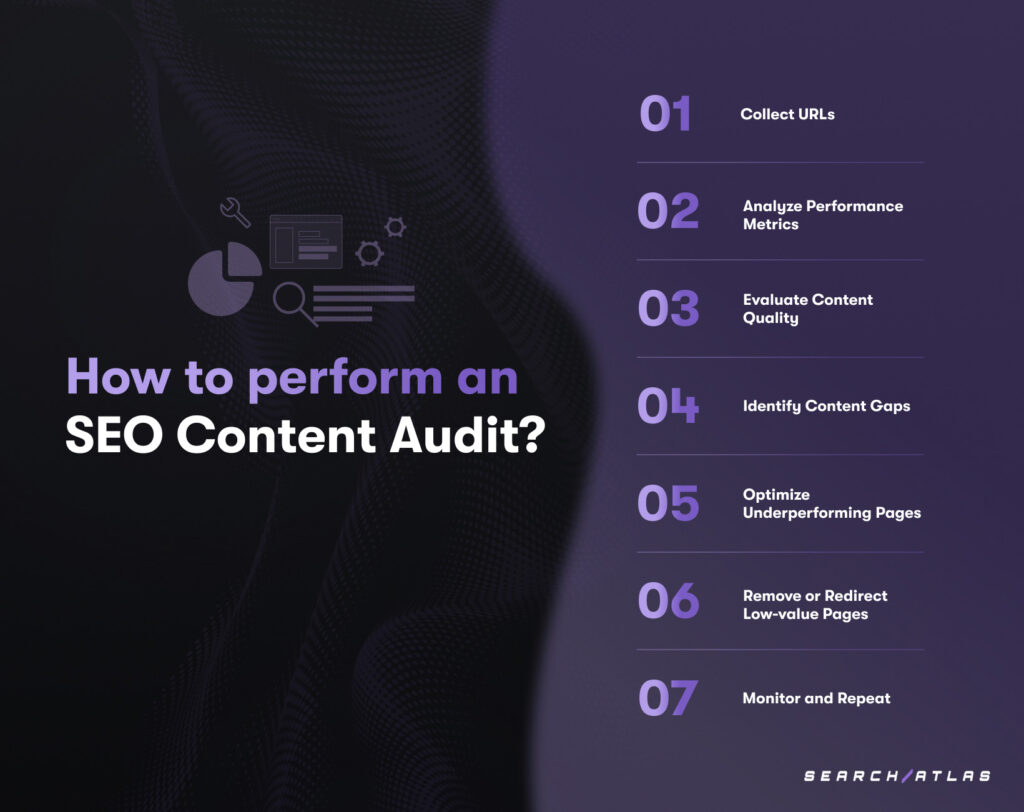
An SEO content audit is a process of analyzing and optimizing website content to improve search engine rankings, user engagement, and overall performance. Content SEO audit helps identify outdated, underperforming, or missing content that can be optimized or replaced for better SEO results.
To perform an SEO content audit, follow the steps listed below.
- Collect all URLs. Use tools like the Search Atlas Site Audit Tool to gather a list of your website’s pages.
- Analyze performance metrics. Evaluate traffic, engagement, and conversion rates using Google Analytics and Search Console.
- Evaluate content quality. Assess relevance, readability, and accuracy.
- Identify content gaps. Determine missing topics or underperforming areas that need new content.
- Optimize underperforming pages. Improve on-page SEO, update outdated information, and enhance user experience.
- Remove or redirect low-value pages. Delete duplicate content and redirect irrelevant or outdated pages to relevant ones.
- Monitor and repeat. Perform regular SEO content analysis to maintain performance and keep it aligned with SEO best practices.
What are the best SEO Content Optimization Tools?
The best SEO content optimization tools provide essential features for analyzing, refining, and enhancing website content for better search visibility. These tools help optimize keyword integration, search intent alignment, metadata, and readability. The SEO content checker tools you chose influence the effectiveness of your content strategy and long-term organic performance.
The best SEO content optimization tools include Google’s free SEO tools, such as Google Search Console and Google Analytics 4, along with AI-powered SEO tools like the Search Atlas SEO software platform. These tools offer real-time analysis, keyword insights, and content writing automation.
Google Search Console (GSC). Serves as the primary SEO content monitoring tool. GSC provides data on organic keyword rankings, search impressions, and click-through rates (CTR). The URL Inspection Tool ensures pages are properly indexed and optimized for search engines.
Google Analytics 4 (GA4). Tracks user engagement and content performance metrics, including bounce rate, time on page, and conversion tracking. GA4’s enhanced measurement features help identify content optimization opportunities.
Google Keyword Planner. Assists in keyword discovery and search volume analysis, helping businesses identify high-impact content opportunities for SEO-driven writing.
Google Trends. Helps track search trends, seasonal keyword variations, and content topic relevance, ensuring content remains timely and competitive.
Search Atlas SEO Software Platform. Serves as a complete AI-powered content optimization platform. Search Atlas. The Search Atlas content optimization tools take keyword research, NLP-based content structuring, AI-powered content writing, and competitor analysis to the next level. Search Atlas’s automated content audit system detects missing keywords, readability issues, and internal linking opportunities, making it a comprehensive solution for SEO content writing and optimization.
Do I Need to Hire an SEO Content Writer?
Yes, hiring an SEO content writer is essential for creating high-quality, search-optimized content that ranks well and engages users.
While SEO content writer software can assist with drafting and keyword placement, AI tools generate text based on existing data but do not ensure fact-checking, contextual relevance, or user engagement. Businesses relying solely on automation risk publishing generic, low-value content that fails to rank or retain visitors.
Writers looking to become SEO content writers need to integrate AI tools into their workflow while maintaining editorial oversight, strategic structuring, and intent-based optimization. AI assists with efficiency, but a strategic SEO content writing guide combined with human expertise ensures accurate, engaging, and authoritative content that meets evolving search engine algorithmic standards.
Does AI Content Affect SEO?
Yes, AI content affects SEO, both positively and negatively. AI tools speed up content creation, suggest topic ideas, and assist with keyword research. However, AI-generated text without contextual structuring, originality, helpfulness, or credibility reinforcement can lead to poor user experience and low retention rates.
When AI-generated content is refined by human editors, optimized for search intent, and supplemented with expert insights, it enhances efficiency without compromising quality. By following a structured AI SEO guide, businesses can optimize AI-generated content for search intent, enhance credibility, and improve long-term organic performance.
What to Know About SEO Content Besides Content Marketing?
SEO content refers to any digital content created to rank in search engines. SEO content is optimized for keywords, structured for readability, and designed to provide valuable, relevant information that matches search intent.
While SEO content focuses on ranking in search engines and driving organic traffic, content marketing is a broader strategy that involves creating and distributing valuable content to attract and engage an audience. Content marketing aims to build brand authority, nurture relationships, and guide potential customers through the buyer’s journey across multiple channels, including social media, email, and paid promotions.
SEO content serves as the foundation for content marketing by ensuring that content is discoverable through search engines. At the same time, content marketing expands the reach of SEO-driven content by distributing it across multiple platforms, increasing brand visibility and engagement. Without SEO, content marketing efforts may struggle to attract organic traffic, and without content marketing, SEO content may lack the depth and variety needed to sustain audience interest and conversions.
What to Know About SEO Content Besides Topical Authority?
SEO content involves optimizing for keywords, structuring content for readability, and aligning with search intent to provide valuable information to users. Topical authority refers to a website’s expertise and credibility in a particular subject area.
While SEO content focuses on optimizing individual pages for search engines, topical authority is built by covering a topic extensively through multiple related pieces of content, internal linking, and high-quality references.
SEO content contributes to topical authority by ensuring that every piece of content is optimized, structured, and relevant to a broader subject area. At the same time, topical authority strengthens the impact of SEO content by signaling to search engines that a website is a trusted source on a given topic. Without SEO optimization, even a site with strong topical authority might struggle to rank, while without topical authority, well-optimized content may lack credibility and competitive strength in search rankings.
What Is the Difference Between SEO Content and On-Page SEO?
SEO content focuses on creating high-quality, keyword-optimized content and aims to answer search queries and provide value to users. It includes blog posts, guides, FAQs, etc.
On-Page SEO involves optimizing page structure, meta tags, and internal linking. On-page SEO enhances readability, page speed, and mobile-friendliness and includes heading optimization, schema markup, and image alt text.
Both work together to improve search rankings, but SEO content is what users engage with, while on-page SEO ensures how search engines interpret it.
What Is the Difference Between SEO Content and Off-Page SEO?
SEO content covers keyword-targeted articles, guides, and other content types. SEO content directly impacts on-site engagement and topical authority and helps increase organic visibility and internal linking opportunities.
Off-page SEO includes backlink building, social media promotion, and brand mentions. Off-page SEO focuses on improving domain authority and external credibility, and it is heavily influenced by outreach, digital PR, and influencer collaborations.
SEO content strengthens a website internally, while off-page SEO enhances its reputation externally.


